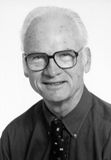Awardee Interviews | Biography: John C. Helmer
John C. Helmer

John C. Helmer, formerly of Varian Associates, "for his many significant contributions to research on molecular beams, Masers, cross-field discharges and plasmas, gas flow in molecular and transition regimes, ion-gettering and hybrid turbo-molecular pumps, and ultrahigh vacuum and surface science instrumentation."
John C. Helmer was born in Evanston, Illinois and attended Lawrence College, Appleton, Wisconsin, graduating Phi Beta Kappa, Magna Cum Laude, with a major in Mathematics and minors in Physics and French Horn. In 1952, he received an M.S. in Physics from California Institute of Technology. In 1956 he received the Ph.D from Stanford University in Electrical Engineering and Microwave Physics, working out of the famous Microwave Laboratory directed by Edward L. Ginzton.
Helmer joined the Varian Associates Tube Division Research Dept. in 1956, working under Robert L. Jepsen. He became a co-inventor of the Vacion pump and he was a founding member of the Varian Research Center. In 1960 he was chosen for the Varian Advanced Training Program, studying Plasma Physics at the Royal Institute of Technology, Stockholm, under Professor Hannes Alven. In 1962 he joined the new Varian Vacuum Division, directed by Louis Malter. He designed gas analyzers and conducted research on molecular flow. He invented the Helmer UHV Gauge with an x-ray limit in the lE-14 torr range, receiving an IR-100 award for his work.
In 1962 Helmer received the IRE Senior Award of the Professional Group on Industrial Electronics, for a paper on the design of "Magnetic Circuits Employing Ceramic Magnets." In this work he developed an original, magnetostatic analysis using Coulomb's law applied to magnetic monopoles. The work continued to serve him throughout his career, as new "hard" magnetic materials become available.
Varian's initiative in surface science led to a project with Lester H. Germer and Norman J. Taylor, developing the first commercial instrument for Low Energy Electron Diffraction (LEED), which received an IR-100 award. His modeling work on: the intensity of electron beams resulted in a LEED design of unusually high intensity, paving the way for a breakthrough in the design of ESCA spectrometers.
In 1968 Helmer joined the Varian Instrument Research Dept. under Weston A. Anderson. With Norbert Weichert, he invented, productized, and developed applications for the first commercial ESCA spectrometer, with a sensitivity 100 times higher than earlier instruments. As director of a small research group, he covered projects related to all Varian Instruments, including spectrophotometry, chromatography, atomic absorption, and NMR. The theory of devices which measure, became a lifelong interest.
In 1978 Helmer re-joined the Varian (Edward L. Ginzton) Research Center, working on industrial plasma devices for coating magnetic recording disks and semiconductor wafers. He established a strong modeling program for optimum design of sputtering sources. The invention of the Conmag-II, dual-ring source, was an outgrowth of this work. Working with Robert L. Anderson, he developed the first quantitative model for a "heart-shaped" rotating magnet, used to control deposition uniformity. This work established the design rules for the Quantum TM sputtering source product line.
In 1988 Helmer was named a Varian Fellow for his sustained contribution to Varian's products and technological base. In 1990, he returned to the instrument field to lead a group in the study of Capillary Electrophoresis for chromatographic analysis. He was co-author in a number of basic publications relating to the formation of electrical double layers between electrolytes and surfaces.
In January 1994, Helmer retired after 37 years of service to Varian in Palo Alto. He continues work on transition gas flow in molecular pumps and turbines with his colleagues at Varian SpA in Turin.
Dr. Helmer is a long-time member of the AVS and the APS. He has 31 journal Publications and the same number of issued patents.
On the personal side, Dr. Helmer was an active racer with his son on San Francisco Bay, skippering a 30' masthead sloop. He learned to design sails, sew with a palm thimble, and repair fiberglass. He rides his road-bike 100 miles per week with a local club. John and Evelyn are fond of the flora and fauna in the mountains and in the desert, in which they indulge whenever they visit their four grandchildren in Eugene, Oregon, and Blythe, California. At home they keep a rose garden of over 100 roses of modern and ancient heritage.